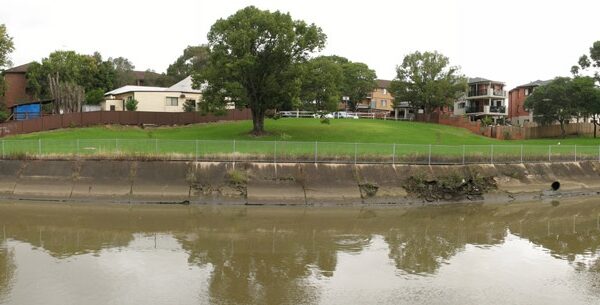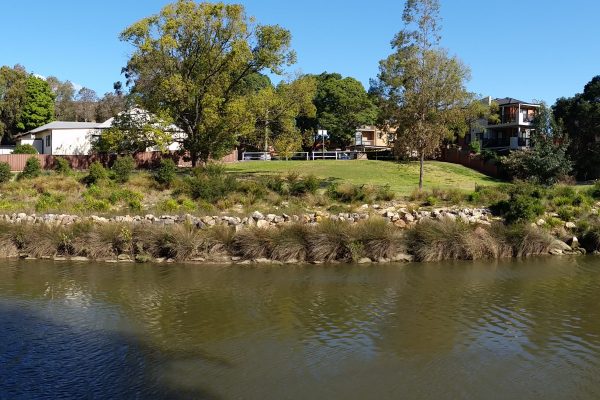case studies
Sydney Water bank naturalisation
Contact
Insight:
Naturalising the deteriorated sections of the concrete river banks along the Cooks River
Project description
The $4.9 million naturalisation of 1.1km of riverbank along the Cooks River in Sydney involved demolishing and replacing steep, deteriorated concrete panels from the 1930s and 1940s with more gently sloped river banks, stabilised with sandstone and more than 80,000 local native plants. The works have created attractive activated spaces for the public and extra habitat for birds and aquatic life. This project included master planning, design and construction of an environmentally friendly riverbank to replace the deteriorated concrete channel at three sites along the Cooks River.
The drivers
Deteriorating condition of concrete channel presented opportunity for channel naturalisation as part of necessary repairs for the waterway
- Repairs required: Significant repairs were needed on the existing concrete channel which was built in the 1930s and 40s. This created an opportunity for change, and greater overall project outcomes through bank naturalisation.
- Improved river health: The project was an opportunity to increase the natural character of the Cooks River, while maintaining the stability of the river banks and flood water capacity.
The innovations
Naturalisation delivered through the removal of concrete, change of slope and revegetation
- Preliminary planning and investigations (asset inspections): Sydney Water invested in early investigations and planning to identify sections of the Cooks River that were feasible for bank naturalisation.
- Demolition of concrete channel and naturalisation of river banks: The existing concrete channel was replaced with a gentler river bank using 80,000 local native plants, trees and sandstone. Bank stabilisation was achieved using sandstone keyed into the gentler bank edges, as well as relying on vegetation establishment to assist in long term bank stabilisation.
- Local habitat and stormwater treatment wetlands: A 2,500m2 freshwater wetland with a fauna underpass underneath the adjacent cycleway was also constructed, which links to the Cooks River.
- Inclusion of new paths, seats and interpretive signage: Park infrastructure provided for landscape, amenity and education.
- Dual-purpose and shared flood study: A flood study was undertaken for design and analysis purposes, while concurrently working in partnership with local councils and other agencies. The flood study was then made available more broadly to assist local floodplain management.
- Incorporation of endangered salt-marsh vegetation into newly naturalised banks: Planting was specifically selected for environmental conditions and local ecological enhancement.
Before and After
The lessons
- Early investigations and planning: Asset inspections and the master planning process were considered a valuable approach by Sydney Water because naturalisation is possible only where there is available adjacent open space, and where works would not affect underground and overhead services and flooding potential.
- Community engagement: The master planning process provided an opportunity to consult with local councils and community groups along Cooks River, resulting in better engagement and community outcomes.
- Shared flood study: The flood model was able to be procured for multiple purposes and in partnership with local councils and other agencies for both the design and analysis of the Cooks River naturalisation project. The result was a more broadly available flood model to assist in local floodplain management.
Transferability
Channel naturalisation projects have global transferability, where there is adequate room (width) for channel modifications. These projects are particularly beneficial / successful where they are located adjacent to open space, where ecological connectivity can be improved, and where the site is not overly constrained by underground or overhead services and /or flood behaviour. Constraints to channel naturalisation can typically be addressed through design, however, the degree of channel naturalisation and riparian restoration will vary depending on the limitations of the site.
Project stats
Location
Sydney, NSW, Australia
Participants
Awards
Excellence in Integrated Stormwater Design - NSW Stormwater Industry Association 2017
Additional information
Contact
The outcomes
 Cities providing ecosystem services
Cities providing ecosystem services

- Native vegetation: Over 28,000m2 of new native vegetation to create habitat for both native birds and animals. Several vegetation communities were recreated including freshwater and brackish swamp communities; clay plain scrub forest; turpentine ironbark forest; coastal saltmarsh.
- Stormwater treatment and habitat: 2,500m² freshwater wetland providing stormwater treatment and aquatic habitat.
 Cities as water supply catchments
Cities as water supply catchments

 Cities comprising water sensitive communities
Cities comprising water sensitive communities

- Interpretive signage: Five signs explaining the benefits and history of river naturalisation.
- Place making and social nexus: Opportunity for the community to reconnect with a natural river and somewhere to connect with other people.
- Actively involved community: Opportunity to provide feedback in the consultation process through the design period created local area pride and positivity for the project results. Bushcare volunteers help maintain new native vegetation.
Business case
| Costs | Benefits |
|
|
Interested in this solution?
We partner with small and large companies, government and industry in Australia and around the world.


Comments